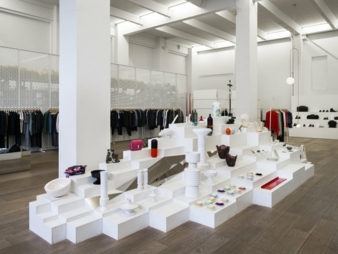20/07/2020 – Part 1: The market of luxury, street- & sportswear — auf Deutsch lesen
The Future of Fashion: New partnerships between design and technology
In our three-part summer interview with Joachim Schirrmacher, a true expert on the fashion scene, we take a look at the future of the industry.
Joachim Schirrmacher is a respected authority on the German and international fashion industry. Based in Berlin, Joachim Schirrmacher works as a creative consultant and author. He chairs the Advisory Board of the German Fashion Industry Foundation – SDBI and is Director of the European Fashion Awards FASH, promoting young talent. He was a Member of the Board of the German Society for Design Theory and Research – DGTF.
The interview was conducted by editor-in-chief Iris Schlomski on behalf of textile network.
Bricks-and-mortar retail sales are still high. Sportiness is a key element in the fight for jobs, partners and status. Joachim Schirrmacher
textile network: What is the status of luxury in Germany?
Joachim Schirrmacher: Germany is an important market for luxury goods, even though luxury is rarely celebrated here and tends to have a rather clean appearance, reminiscent of the “Murkudis” concept store. Brands such as Mercedes, Miele, Rimowa and A. Lange & Söhne are revered as luxury goods internationally, but in Germany they are associated with respectability and quality.
textile network: How important is the role played by German based fashion designers?
Joachim Schirrmacher: The field is led mostly by niche products such as those by Acronym, Iris von Arnim, GmbH, Diehm Bespoke, Horror Vacui, Mykita, Odeeh, Nobi Talai or 032c. You’ll also find German designers working for almost every international fashion house, often as head of department.
textile network: Online shops are booming. Which names stand out here?
Joachim Schirrmacher: Zalando and Highsnobiety from Berlin, Mytheresa from Munich and the Otto Group with its more than 100 companies, like About You. Otto is widely considered the second biggest online trading company in the world, but in contrast to Amazon or Zalando, it has almost always been profitable. There are several new online stores specifically for fair fashion, such as thewearness.
And we shouldn’t forget the bricks-and-mortar retailers. It wasn’t until they had to close during lockdown that we became aware of just how high their sales are.
textile network: Do you think that sport- and streetwear and performance wear will continue to experience growth?
Joachim Schirrmacher: Both segments have had a strong commercial footing in Germany for decades and they’re still experiencing growth. This is reflected in the turnover of corporations such as Adidas and Puma, and in the world’s leading trade fairs: Ispo and Outdoor for sport, and previously Interjeans in Cologne and Bread and Butter for jeans and streetwear.
textile network: Why is sportswear so important?
Joachim Schirrmacher: Sportiness is a key element in the fight for jobs, partners and status in Germany. By implementing a “smart-casual” dress code, companies want to be perceived as attractive employers. And even today’s pensioners prefer the Rolling Stones to classical concerts and Acne jeans rather than slacks. Health and physicality have become even more important since the coronavirus reared its head. Every form of fashion is having to embrace this new sense of freedom.
Of course, this doesn’t mean that everyone’s walking around in joggers. On the contrary, people want to live life to the full, and they want to take pleasure in the power of beauty. Even before the pandemic, there was a perceived longing to dress up rather than down. But if you wear a suit today, it’s more likely to be casual – à la Nicolas Bos of Van Cleef & Arpels – and not because you have to but because you want to.
Although we’re always talking about the globalisation of trends, here in Berlin there’s a different look in every neighbourhood. Life is much more diverse than is perhaps reflected by the fashion media and brands.
Part 2: Research and development for real changes. Read Online
Part 3: How can we give Fair Fashion a different value? Read Online





